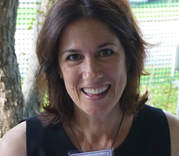 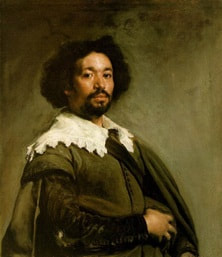 Diego Velázquez, "Portrait of Juan de Pareja," 1650,Oil on canvas, 81.3 x 69.9 cm, Metropolitan Museum of Art, New York, New York, USA Diego Velázquez, "Portrait of Juan de Pareja," 1650,Oil on canvas, 81.3 x 69.9 cm, Metropolitan Museum of Art, New York, New York, USA Diego Velazquez (1599 – 1660) was a famous Spanish painter. He had a slave named Juan de Pareja (1606 – 1670). Call him an indentured servant if you want, but it’s more accurate to say he was Velazquez's slave, as he was not at liberty to leave. For years, Pareja prepared brushes, ground pigments, and stretched canvasses for the artist. While he was at it, Pareja observed his master carefully, and secretly taught himself how to use the materials, and how to paint. Pareja was referred to as a Morisco in Spanish. One way to translate the word is that he had mixed parentage (the offspring of a European Spaniard and a person of African descent). Another way to translate the word is that he was a Moor—someone descended from Muslims who had remained in Spain after its conquest by Ferdinand and Isabella. In 1650, Velazquez was preparing to paint a portrait of Pope Innocent X. As practice, he painted Pareja, who had accompanied the artist to Italy. Here is the portrait. It's a pretty amazing picture, isn't it? Velazquez got all sorts of praise for it from the artists in Rome—he was even elected into the Academy of St. Luke. According to some sources, Velazquez would not allow Pareja to pick up a paintbrush. But one day, when King Philip IV was due to visit Velazquez, Pareja placed one of his own paintings where the king would see it. When the king admired it, believing it to be by Velazquez, Pareja threw himself at the king’s feet and begged for the King to intercede for him. Whether or not that story is true, Pareja did become an accomplished painter, and impressed the king so much that he ordered Pareja freed. Pareja remained with the Velazquez family until his death. It was hard to find examples of his paintings, but here are two that are attributed to him.  Sarah Albee's latest book is Poison: Deadly Deeds, Perilous Professions and Murderous Medicines. You can read a review that gives you a dose of what's in this book. MLA 8 Citation Albee, Sarah. "The Painter Was a Slave." Nonfiction Minute, iNK Think Tank, 25 Oct. 2017, www.nonfictionminute.org/the-nonfiction-minute/the-painter-was-a-slave.
1 Comment
 A common punishment for those accused of a crime in seventeenth century Europe was to be sent to the galleys. That meant spending the rest of your life at an oar in the dark, stinking hold of a ship. Wind and oars were the only known propellant of the age. Paid employment at the oar had been tried and dismissed. The only reliable way to produce the necessary speed and endurance to chase down (or escape from) enemy ships or Barbary pirates was to use the whip on your oarsmen, something that didn’t go over well with paid employees. But as condemned criminals were plentiful in that era, it wasn’t difficult to find oarsmen. When in 1685 Louis XIV revoked the Edict of Nantes—a law passed by his grandfather Henry IV that had ensured the freedom of Protestant worship in France—many French Protestants (known as Huguenots) who tried to flee the country were sent to the galleys. What was life like as a galley slave? We know something about it from letters and memoirs of Huguenot convicts. After a long and often grueling march to the ports, the convicts would be sorted into groups of five—these would become the people with whom one would eat, sleep, and work, often until one died of old age or overwork or both. Each group of five men manned an eighteen-foot oar–and there might be fifty oars on a ship. The convicts remained chained to their places. With each stroke, they had to rise together and push the oar forward, and then dip it in the water and pull backward, dropping into a sitting position. During battle, rowers might be required to maintain full speed for twenty-four hours straight, and be fed biscuits soaked in wine without pausing in their exertions. Those who died—or lost consciousness—were thrown overboard. Horrific, yes. But there were at least some brief respites from the wretched existence, periods of time when the wind’s sails propelled the ship and the rowers could rest. And when the ship overwintered in port, the life of a gallérien became almost tolerable. They had room to lie down and sleep. Many gallériens learned to knit, and others were already skilled wig makers, tailors, and musicians—and were allowed to employ their trades in rotating weeks ashore. 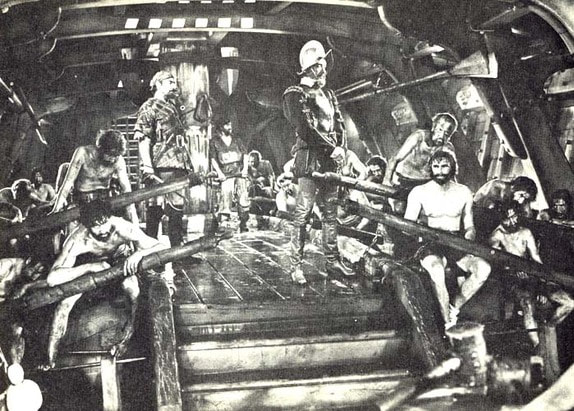 In his memoirs, a Huguenot named Jean Marteilhe wrote about his capture in 1701 as a boy of 17, and his experiences as a galley slave having been chained together with other deserters, thieves, smugglers, Turks and Calvinists for 6 years from 1707 to 1713. His account is entitled Memoirs of a Galley Slave of the Sun King. 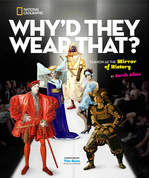 Sara Albee's book Why'd They Wear That? is published by National Geographic. Get ready to chuckle your way through centuries of fashion dos and don'ts! In this humorous and approachable narrative, you will learn about outrageous, politically-perilous, funky, disgusting, regrettable, and life-threatening creations people have worn throughout the course of human history, all the way up to the present day. For more information, click here. MLA 8 Citation
Albee, Sarah. "Row, Row, Row Your Boats." Nonfiction Minute, iNK Think Tank, 22 Mar. 2018, www.nonfictionminute.org/the-nonfiction-minute/ Row-Row-Row-Your-Boats.  Since 1775, Americans in the 13 British Colonies had been fighting to free themselves from mighty Great Britain. The French didn’t care for the British, having had their own wars with them, so many a Frenchman came to help the Americans. One was a teenaged aristocrat, the Marquis de Lafayette. He so admired America’s revolutionary ideals of liberty and democracy that he sailed there in 1777 to offer his money and services to his idol, General George Washington. By 1781, General Lafayette was leading French and American troops, battling the British in Virginia. Now a fellow there named James Armistead joined the fight, once he got his master’s permission. After all, Armistead was an enslaved African American. What did he do? He hung around the British, finding out what they were up to – dangerous work! Then Armistead, patriot spy, took his info to General Lafayette, who used it to help beat the British at Yorktown in October 1781, which, in turn, led to the United States’ victory in the Revolutionary War. The Marquis went back to France. Armistead went back to work for his master. Though he’d helped win America’s independence, he did not win his. When Lafayette made a return visit in 1784, he was outraged to find his fellow veteran still enslaved! The Marquis saw to it that Armistead was freed and the former slave showed his gratitude by changing his name to James Armistead Lafayette. But this isn’t how the story ends. Forty years later, the Americans invited the Marquis to come for a visit. He’d grown old. He’d suffered in prison during France’s own revolution in the 1790s. How splendid it was, visiting the United States— all 24 of them! Oh, the parties and banquets the Americans had for their old friend! But one of the happiest moments of all was in early 1825. The old aristocrat was riding in a parade through Richmond, Virginia, when he spotted a white-haired black gentleman in the crowd. The Marquis reined in his horse, dismounted, and went to greet James Armistead Lafayette. And the two old heroes of the American Revolution flung their arms around one another. 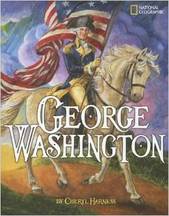 Cheryl Harness uses her wonderfully vibrant art and down-to-earth writing style to present George the adventurous boy, tromping through the woods with his dog and his hunting rifle; George the courageous military leader fighting alongside his men; George the cunning military strategist, outfoxing the British and forcing their surrender at Yorktown; George the brilliant statesman presiding over the Constitutional Convention; and George the President, wisely protecting our country from enemies foreign and domestic so it could grow strong. For more information, click here. MLA 8 Citation
Harness, Cheryl. "The Aristocrat and the Spy." Nonfiction Minute, iNK Think Tank, 10 Apr. 2018, www.nonfictionminute.org/the-nonfiction-minute/ the-aristocrat-and-the-spy.  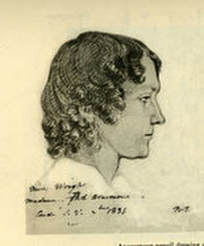 An 1835 Sketch of "Miss Wright" An 1835 Sketch of "Miss Wright" When she was a girl in Scotland, Frances or “Fanny” Wright fell in love with America, a new nation “consecrated to freedom.” On September 3, 1818, the 22-year-old writer set foot on that actual land of her dreams. She and her little sister Camilla, a pair of wealthy orphans, spent the next two years touring the young U.S. Young females did NOT go traveling without a man in those days, but Fanny believed that freedom should apply to women too! Her 1821 book about her travels won her the friendship of another freedom fan, the Marquis de Lafayette, who’d helped free America from the British Empire. In 1824, the old Frenchman made sure Fanny met his friend, 81-year-old Thomas Jefferson and his friend, 73-year-old James Madison. But wait – maybe you already see a fly in the soup. To Fanny, “slavery was revolting everywhere.” Slaves in the Land of Liberty was sickening! As much as she admired the two former presidents, she hated that they lived in slave-built mansions, waited on by people who had no choice but to do so. But slavery really did trouble them, too. Slavery trapped everyone in its evilness. With so much money tied up in costly human property, owners couldn’t afford to let them go. Could blacks support themselves, after lifetimes of being fed, housed, and denied education? Madison and Jefferson thought no; emancipation had to be gradual. Really, centuries of racial division had them and their countrymen thinking that the races could never live together. Surely blacks must go back to Africa! (In fact, many had already been sent there, to Monrovia, but that’s another story for another day.) So Fanny planned farms where blacks could learn while they earned their freedom money. It was her way of freeing her beloved America from the curse of slavery. She published her idea and tried to make it work on Nashoba, her own farm in Tennessee, but her experiment failed. Then, in the late 1820s, she went around the eastern US, making speeches about all of her freethinking ideas and shocking the daylights out of people. A public-speaking woman was unheard of! Going around, talking about abolition, day care for working mothers, the rights of women and factory workers? SHOCKING! That’s the thing to know about Fanny Wright: She was one stubborn radical, WAY ahead of her time, imagining freedoms she never lived to see. 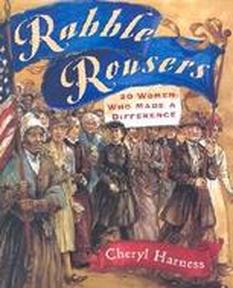 Cheryl Harness has written (and illustrated) short, spirited profiles of twenty women who impacted life in America by speaking out against injustice and fighting for social improvements. The book spans over two hundred years of American history and includes time lines for such important social movements as abolition, woman suffrage, labor, and civil rights. Readers inspired by these fiery women can use the civil action tips and resources in the back of the book to do some of their own rabble-rousing. For more information, click here. MLA 8 Citation
Harness, Cheryl. "Shocking Fanny Wright." Nonfiction Minute, iNK Think Tank, 1 Mar. 2018, www.nonfictionminute.org/the-nonfiction-minute/ shocking-fanny-wright. Why is Black History Month celebrated in February? The answer is really quite love-ly. For Black people enslaved, a birthday was as hard to come by as justice. But, never one to be outdone by the “impossible,” Frederick Bailey wanted a birthday—and a birthday he was going to have. First, he'd have to find out when it was. He’d heard that his father was the slave owner from whom he'd escaped, so he couldn't ask him. His mother, Harriet Bailey, had been sold away from him when he was only five, so he couldn't ask her. But, he could remember stories she'd told him before they’d been separated. She said he was born on a Maryland plantation in the ‘teens. He chose the mid-teens, 1818, for his birth year. She always called him her “little valentine.” He chose Valentine’s Day for his birth date. With that, Frederick finally had the birthday he'd always wanted: February 14, 1818. Then . . . In 1926, Dr. Carter G. Woodson wanted to solve a problem. For centuries, Americans were taught to believe that African Americans had “no history or culture.” Now that is, of course, impossible. Everyone inherits the history and culture of their family elders. But, this horrific idea was used to justify slavery and segregation by making Black people seem less than human. Dr. Woodson had a better idea: he’d tell the truth. He would research and share the true history of Black people in countries throughout the world over. To promote his idea, he created Negro History Week (now, Black History Month). He chose February in honor of two birthdays. Born on February 12, 1809, Abraham Lincoln was the first American president to take action to end slavery. Born on February 14, 1818 Harriet Bailey’s “little Valentine's” became the noted Underground Railroad conductor, abolitionist, and publisher, Frederick Douglass. As a special adviser to President Lincoln, he proposed—and the president wrote and signed—the “Emancipation Proclamation”; ending slavery. Such is the power of love. We never know how we will remember what our parents say or what their words will mean to us when we need them most. Frederick's mother—an enslaved woman with so little to give—empowered her son for life with the gift of her enduring love. For this love-ly reason, February is Black History Month. Frederick Bailey's mother was sold to a new owner, leaving the 5-year-old behind. This was a common practice in the slavery era. Abraham Lincoln's successful campaign to end slavery in the United States culminated in the Emancipation Declaration of 1863. Alexander Gardner via Wikimedia Commons ;In 1926, Carter G. Woodson (left) shown here as a young man, pioneered the celebration of "Negro History Week" during the second week in February, to coincide with marking the birthdays of Abraham Lincoln (above) and Frederick Douglass (right). Black United Students and Black educators at Kent State University expanded the celebration to become Black History Month on February 1, 1970. Woodson Courtesy of the New River Gorge National River website, National Park Service, Department of the Interior, United States Government; Douglass via Wikimedia Commons. 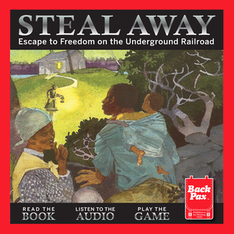 Janus Adams has produced Steal Away-- a package of a book, an audio and a game about the Underground Railroad. You can learn more about her award-winning series of adventure and travel books, audios and games on her website called Back Pax Kids. MLA 8 Citation
Adams, Janus. "Title tbd." Nonfiction Minute, iNK Think Tank, 28 Feb. 2018, www.nonfictionminute.org/the-nonfiction-minute/ why-is-february-black-history-month. |
*NEWS
|
For Vicki Cobb's BLOG (nonfiction book reviews, info on education, more), click here: Vicki's Blog
The NCSS-CBC Notable Social Studies Committee is pleased to inform you
that 30 People Who Changed the World has been selected for Notable Social Studies Trade Books for Young People 2018, a cooperative project of the National Council for the Social Studies (NCSS) & the Children’s Book Council
Categories
All
Abolitionists
Adams Janus
Adaptation
Adaptations
Adkins Jan
Advertising
Aerodynamics
Africa
African American History
African Americans
Africa West
Agriculture
Aircraft
Air Pilots
Air Pressure
Air Travel
Albee Sarah
Alchemy
Alligators
Allusion
American History
American Icons
Amphibians
Amundsen Roald
Anatomy
Ancient
Ancient Cultures
Anderson Marian 1897-1993
Animal Behavior
Animal Experimentation
Animal Intelligence
Animals
Animation
Antarctica
Ants
Apache Indians
Apes
April Fool's Day
Architecture
Argument
Arithmetic
Art
Art Deco
Artists
Arts
Asia
Astronauts
Astronomy
Athletes
Atomic Theory
Audubon Societies
Authors
Autobiography
Automobiles
Aviation
Awards
Bacteria
Baseball
Battuta Ibn
Bears
Beatles
Beavers
Bees
Biodegradation
Biography
Biology
Biomes
Biomimicry
Biplanes
Birds
Black Death
Black History
Blindness
Blizzards
Bombs
Bonaparte Napoleon
Boone Daniel
Botany
Brazil
Bridges
Brill Marlene Targ
Brooklyn Bridge
Brown John
Buffaloes
Building Materials
Butterflies
Caesar
Caesar Julius
Caissons
Calculus
Calendars
Cannibal
Capitals
Caravaggio
Carbon Dioxide
Carnivores
Carson Mary Kay
Cartoons & Comics
Carving (Decorative Arts)
Cascade Range
Castaldo Nancy
Castles
Castrovilla Selene
Cathedrals
Cats
Caves
Celts
Cemeteries
Chemistry
Children's Authors
Child Welfare
China
Choctaw Indians
Christmas
Chronometers
Cicadas
Cinco De Mayo
Ciphers
Circle
Citizenship
Civil Rights
Civil Rights Movements
Civil War
Civil War - US
Climate
Climate Change
Clocks And Watches
Clouds
Cobb Vicki
COBOL (Computer Language)
Code And Cipher Stories
Collard III Sneed B.
Collectors And Collecting
Color
Commerce
Communication
Competition
Compilers
Composers
Computers
Congressional Gold Medal
Consitution
Contests
Contraltos
Coolidge Calvin
Cooling
Corms
Corn
Counterfeiters
Covid-19
Crocodiles
Cryptography
Culture
Darwin Charles
Declaration Of Independence
Decomposition
Decompression Sickness
Deep-sea Animals
Deer
De Medici Catherine
Design
Detectives
Dickens Charles
Disasters
Discrimination
Diseases
Disney Walt
DNA
Dogs
Dollar
Dolphins
Douglass Frederick 1818-1895
Droughts
Dr. Suess
Dunphy Madeleine
Ear
Earth
Earthquakes
Ecology
Economics
Ecosystem
Edison Thomas A
Education
Egypt
Eiffel-gustave-18321923
Eiffel-tower
Einstein-albert
Elephants
Elk
Emancipationproclamation
Endangered Species
Endangered-species
Energy
Engineering
England
Englishlanguage-arts
Entomology
Environmental-protection
Environmental-science
Equinox
Erie-canal
Etymology
Europe
European-history
Evolution
Experiments
Explorers
Explosions
Exports
Extinction
Extinction-biology
Eye
Fairs
Fawkes-guy
Federalgovernment
Film
Fires
Fishes
Flight
Floods
Flowers
Flute
Food
Food-chains
Foodpreservation
Foodsupply
Food-supply
Football
Forceandenergy
Force-and-energy
Forensicscienceandmedicine
Forensic Science And Medicine
Fossils
Foundlings
France
Francoprussian-war
Freedom
Freedomofspeech
French-revolution
Friction
Frogs
Frontier
Frontier-and-pioneer-life
Frozenfoods
Fugitiveslaves
Fultonrobert
Galapagos-islands
Galleys
Gametheory
Gaudi-antoni-18521926
Gender
Generals
Genes
Genetics
Geography
Geology
Geometry
Geysers
Ghosts
Giraffe
Glaciers
Glaucoma
Gliders-aeronautics
Global-warming
Gods-goddesses
Gold-mines-and-mining
Government
Grant-ulysses-s
Grasshoppers
Gravity
Great-britain
Great-depression
Greece
Greek-letters
Greenberg Jan
Hair
Halloween
Handel-george-frederic
Harness Cheryl
Harrison-john-16931776
Health-wellness
Hearing
Hearing-aids
Hearst-william-randolph
Henry-iv-king-of-england
Herbivores
Hip Hop
History
History-19th-century
History-france
History-world
Hitler-adolph
Hoaxes
Holidays
Hollihan Kerrie Logan
Homestead-law
Hopper-grace
Horses
Hot Air Balloons
Hot-air-balloons
Housing
Huguenots
Human Body
Hurricanes
Ice
Icebergs
Illustration
Imagery
Imhotep
Imperialism
Indian-code-talkers
Indonesia
Industrialization
Industrial-revolution
Inquisition
Insects
Insulation
Intelligence
Interstatecommerce
Interviewing
Inventions
Inventors
Irrational-numbers
Irrigation
Islands
Jacksonandrew
Jazz
Jeffersonthomas
Jefferson-thomas
Jemisonmae
Jenkins-steve
Jet-stream
Johnsonlyndonb
Jokes
Journalism
Keeling-charles-d
Kennedyjohnf
Kenya
Kidnapping
Kingmartinlutherjr19291968
Kingmartinlutherjr19291968d6528702d6
Kings-and-rulers
Kings Queens
Kings-queens
Koala
Labor
Labor Policy
Lafayette Marie Joseph Paul Yves Roch Gilbert Du Motier Marquis De 17571834
Landscapes
Languages-and-culture
Law-enforcement
Layfayette
Levers
Levinson Cynthia
Lewis And Clark Expedition (1804-1806)
Lewis Edmonia
Liberty
Lift (Aerodynamics)
Light
Lindbergh Charles
Liszt Franz
Literary Devices
Literature
Lizards
Longitude
Louis XIV King Of France
Lumber
Lunar Calendar
Lynching
Macaws
Madison-dolley
Madison-james
Madison-james
Mammals
Maneta-norman
Maneta-norman
Marathon-greece
Marine-biology
Marine-biology
Marines
Marsupials
Martial-arts
Marx-trish
Mass
Massachusetts-maritime-academy
Mass-media
Mastodons
Mathematics
May-day
Mcclafferty-carla-killough
Mcclafferty-carla-killough
Mckinley-william
Measurement
Mechanics
Media-literacy
Media-literacy
Medicine
Memoir
Memorial-day
Metaphor
Meteorology
Mexico
Mickey-mouse
Microscopy
Middle-west
Migration
Military
Miners
Mississippi
Molasses
Monarchy
Monsters
Montgomery
Montgomery-bus-boycott-19551956
Montgomery-heather-l
Monuments
Moon
Moran-thomas
Morsecode
Morsesamuel
Moss-marissa
Moss-marissa
Motion
Motion-pictures
Mummies
Munro-roxie
Munro-roxie
Musclestrength
Museums
Music
Muslims
Mythologygreek
Nanofibers
Nanotechnology
Nathan-amy
Nathan-amy
Nationalfootballleague
Nationalparksandreserves
Nativeamericans
Native-americans
Native-americans
Naturalhistory
Naturalists
Nature
Nauticalcharts
Nauticalinstruments
Navajoindians
Navigation
Navy
Ncaafootball
Nervoussystem
Newdeal19331939
Newman-aline
Newman-aline
Newton-isaac
New-york-city
Nobelprizewinners
Nomads
Nonfictionnarrative
Nutrition
Nylon
Nymphs-insects
Oaths Of Office
Occupations
Ocean
Ocean-liners
Olympics
Omnivores
Optics
Origami
Origin
Orphans
Ottomanempire
Painters
Painting
Paleontology
Pandemic
Paper-airplanes
Parksrosa19132005
Parrots
Passiveresistance
Patent Dorothy Hinshaw
Peerreview
Penguins
Persistence
Personalnarrative
Personification
Pets
Photography
Physics
Pi
Pigeons
Pilots
Pinkertonallan
Pirates
Plague
Plains
Plainsindians
Planets
Plantbreeding
Plants
Plastics
Poaching
Poetry
Poisons
Poland
Police
Political-parties
Pollen
Pollution
Polo-marco
Populism
Portraits
Predation
Predators
Presidentialmedaloffreedom
Presidents
Prey
Prey-predators
Prey-predators
Prime-meridian
Pringle Laurence
Prohibition
Proteins
Protestandsocialmovements
Protestants
Protestsongs
Punishment
Pyramids
Questioning
Radio
Railroad
Rainforests
Rappaport-doreen
Ratio
Reading
Realism
Recipes
Recycling
Refrigerators
Reich-susanna
Religion
Renaissance
Reproduction
Reptiles
Reservoirs
Rheumatoidarthritis
Rhythm-and-blues-music
Rice
Rivers
Roaringtwenties
Roosevelteleanor
Rooseveltfranklind
Roosevelt-franklin-d
Roosevelt-theodore
Running
Russia
Safety
Sanitation
Schwartz David M
Science
Scientificmethod
Scientists
Scottrobert
Sculpture
Sculpturegardens
Sea-level
Seals
Seals-animals
Secretariesofstate
Secretservice
Seeds
Segregation
Segregationineducation
Sensessensation
September11terroristattacks2001
Seuss
Sextant
Shackletonernest
Shawneeindians
Ships
Shortstories
Silkworms
Simple-machines
Singers
Siy Alexandra
Slavery
Smuggling
Snakes
Socialchange
Social-change
Socialjustice
Social-justice
Socialstudies
Social-studies
Social-studies
Sodhouses
Solarsystem
Sound
Southeast-asia
Soybean
Space Travelers
Spain
Speech
Speed
Spiders
Spies
Spiritualssongs
Sports
Sports-history
Sports-science
Spring
Squirrels
Statue-of-liberty
STEM
Storms
Strategy
Sugar
Sumatra
Summer
Superbowl
Surgery
Survival
Swanson-jennifer
Swinburne Stephen R.
Synthetic-drugs
Taiwan
Tardigrada
Tasmania
Tasmanian Devil
Tasmanian-devil
Technology
Tecumsehshawneechief
Telegraph-wireless
Temperature
Tennis
Terrorism
Thomas Peggy
Thompson Laurie Ann
Time
Titanic
Tombs
Tortoises
Towle Sarah
Transcontinental-flights
Transportation
Travel
Trees
Trung Sisters Rebellion
Tundra
Turnips
Turtles
Typhoons
Underground Railroad
Us-environmental-protection-agency
Us History
Us-history
Ushistoryrevolution
Us History Revolution
Us-history-war-of-1812
Us Presidents
Ussupremecourtlandmarkcases
Vacations
Vaccines
Vangoghvincent
Vegetables
Venom
Vietnam
Viruses
Visual-literacy
Volcanoes
Voting-rghts
War
Warne-kate
Warren Andrea
Washington-dc
Washington George
Water
Water-currents
Wax-figures
Weapons
Weather
Weatherford Carole Boston
Whiting Jim
Wildfires
Winds
Windsor-castle
Wolves
Woman In History
Women
Women Airforce Service Pilots
Women-airforce-service-pilots
Womeninhistory
Women In History
Women-in-science
Women's History
Womens-roles-through-history
Wonder
Woodson-carter-godwin-18751950
World-war-i
World War Ii
World-war-ii
Wright Brothers
Writing
Writing-skills
Wwi
Xrays
Yellowstone-national-park
Zaunders Bo
ArchivesMarch 2021
February 2021
January 2021
December 2020
November 2020
October 2020
September 2020
June 2020
May 2020
April 2020
March 2020
February 2020
January 2020
December 2019
October 2019
September 2019
August 2019
July 2019
May 2019
April 2019
March 2019
February 2019
January 2019
December 2018
November 2018
September 2018
June 2018
May 2018
April 2018
March 2018
February 2018
January 2018
December 2017
November 2017
October 2017
September 2017
March 2017
The NONFICTION MINUTE, Authors on Call, and. the iNK Books & Media Store are divisions of iNK THINK TANK INC.
a 501 (c) (3) nonprofit corporation. To return to the iNK Think Tank landing page click the icon or the link below. :
http://inkthinktank.org/
For more information or support, contact thoughts@inkthinktank.org
For Privacy Policy, go to
Privacy Policy
© COPYRIGHT the Nonfiction Minute 2020.
ALL RIGHTS RESERVED.
This site uses cookies to personalize your experience, analyze site usage, and offer tailored promotions. www.youronlinechoices.eu
Remind me later
Archives
March 2023
February 2023
January 2023
December 2022
November 2022
October 2022
September 2022
June 2022
May 2022
April 2022
March 2022
February 2022
January 2022
December 2021
November 2021
September 2021
April 2021
March 2021
February 2021
November 2020
October 2020
September 2020
June 2020
May 2020
April 2020
March 2020
February 2020
January 2020
October 2019
August 2019
July 2019
May 2019
April 2019
December 2018
September 2018
June 2018
May 2018
March 2018
February 2018
January 2018
December 2017
November 2017
October 2017
September 2017


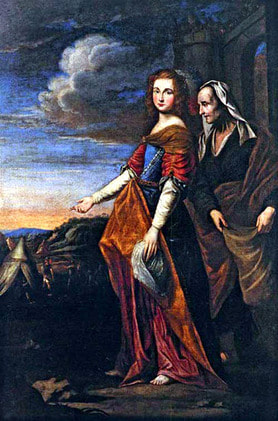
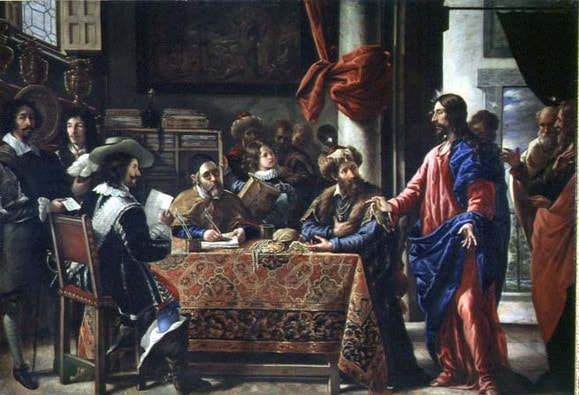


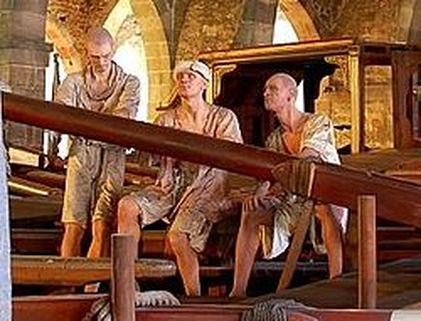
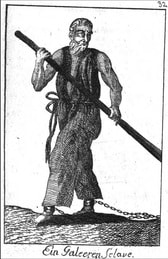
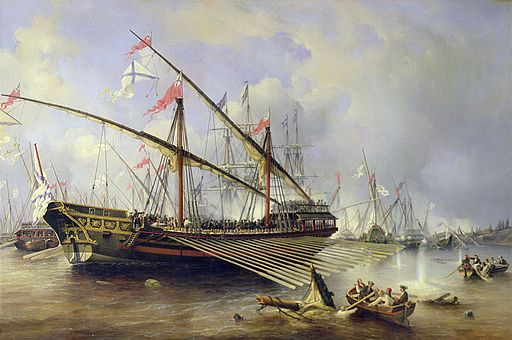


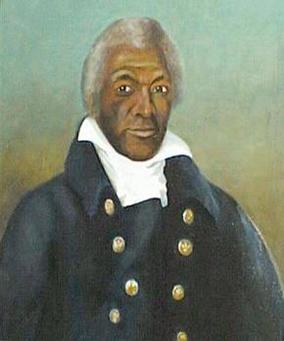
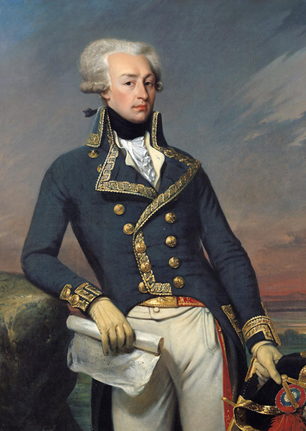
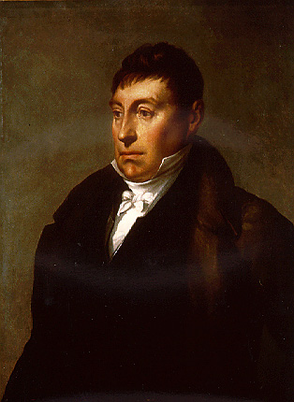


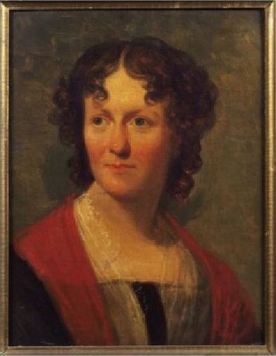
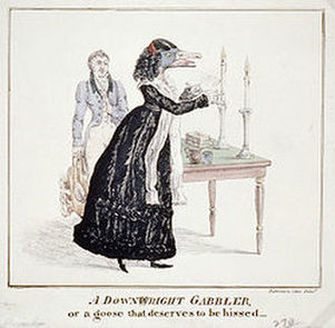

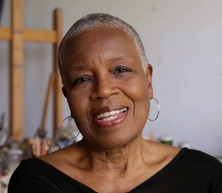

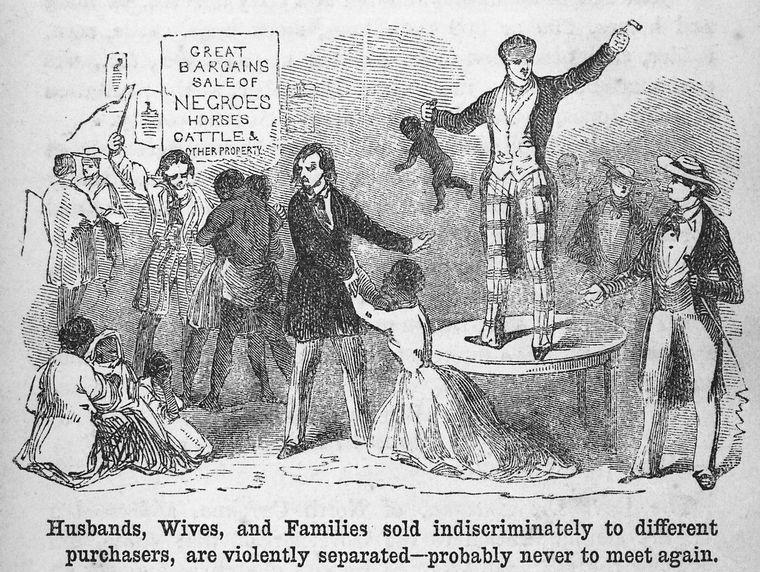

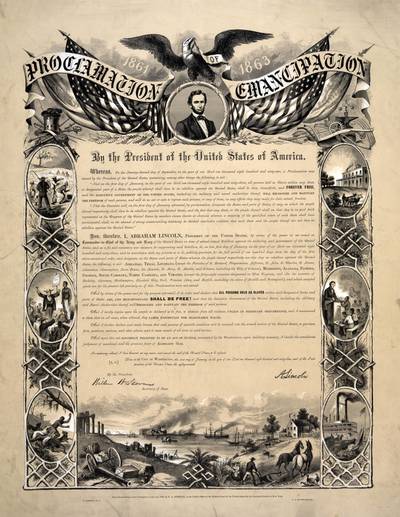
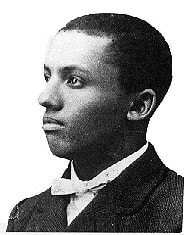
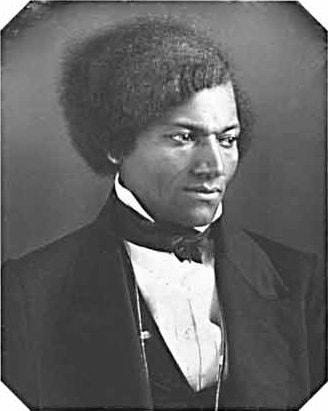

 RSS Feed
RSS Feed
